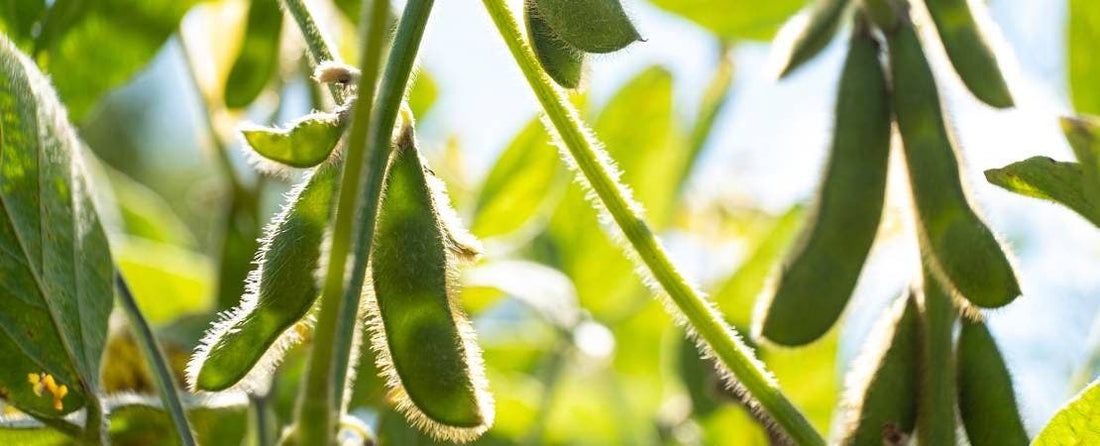
Know Before You Grow: Soybean Seeds
Share
How to Grow Soybeans
Soybeans are versatile, nutritious legumes that flourish in full sun and well-drained soil. Ideal for home gardens, they can be grown for fresh eating, dried for storage, or used as forage for livestock. These warm-weather plants are nitrogen-fixing, improving the soil for future crops and making them a great addition to crop rotations. Soybeans require consistent moisture during germination and early growth stages but are relatively low maintenance once established.
Choosing a Soybean Variety: Classifications and Growing Styles
When selecting soybean seeds, it’s important to understand the different classifications and how they fit your growing goals. Soybeans are classified by their end use, growing habits, and seed colors.
Classifications of Soybeans by End Use
Edamame (Vegetable Soybeans)
These soybeans are harvested when the pods are still young and green, perfect for fresh consumption. Edamame soybeans are known for their tender texture and sweet, nutty flavor. They are typically larger and more flavorful than field soybeans.
Best for: Fresh consumption, cooking as a vegetable.
Field Soybeans (Grain Soybeans)
Field soybeans are grown primarily for drying and processing. These varieties have a harder seed coat and are typically harvested when fully mature and dry. Field soybeans are used in making soybean oil, soy flour, tofu, or even livestock feed.
Best for: Drying and storage, processing for food or feed.
Forage Soybeans
Forage soybeans are grown specifically for livestock feed. They produce more biomass and are more vigorous than typical grain soybeans. These soybeans are ideal for cutting and feeding as silage or for grazing.
Best for: Livestock feed and cover crops.
Classifications by Seed Color
Soybeans also come in different seed colors, each with specific uses and characteristics.
Green Soybeans: Typically used for edamame, green soybeans are harvested early and enjoyed fresh. Their sweet flavor makes them a favorite in many culinary dishes.
Yellow Soybeans:Yellow-seeded soybeans are the most common type used for processing into products like soy milk, tofu, and soy oil. These are harvested once fully mature and dry.
Black Soybeans:Known for their higher levels of antioxidants, black soybeans are often used in traditional cooking or processed into soy flour or fermented products.
Brown and Bicolored Soybeans: While less common, brown and bicolored soybeans are grown for niche markets and often used in specialized foods or cultural dishes.
Growing Styles: Determinate vs. Indeterminate
Determinate Soybeans: These plants stop growing once they reach a certain height and tend to mature all at once. They are ideal for gardeners who want to harvest a full crop in a single period.
Indeterminate Soybeans: Indeterminate varieties continue to grow and produce new pods throughout the season, offering a staggered harvest. These varieties are excellent for home gardeners who want a steady supply of fresh soybeans.
When to Start Soybean Seeds
Soybeans are sensitive to cold and should be planted after the danger of frost has passed. Start soybean seeds directly outdoors in late spring when soil temperatures consistently reach 60°F or higher. In most regions, this will be 1-2 weeks after the last frost date. Starting them too early can result in poor germination or damage to the young plants.
How to Start Soybean Seeds
Sow soybean seeds directly into well-drained soil, 1-1.5 inches deep, with about 2-4 inches of space between each seed. Rows should be spaced 18-30 inches apart. If your soil is heavy clay or tends to retain moisture, consider planting in raised beds to ensure proper drainage. Soybean seeds usually germinate within 7-10 days in warm soil. Soybeans don’t transplant well, so direct sowing is preferred over indoor starting.
Transplanting Soybeans
Soybeans are best grown from direct seeding, so transplanting is not typically recommended. If you do start soybeans indoors, transplant them carefully after they’ve developed a few sets of true leaves and temperatures are consistently warm. Harden them off by gradually exposing them to outdoor conditions for a week before transplanting.
Special Considerations: Annual or Perennial
Soybeans are grown as annuals, completing their life cycle in one growing season. They will grow and produce pods within about 75-100 days, depending on the variety. After harvesting, the plants die back, and new seeds will need to be planted the following year. Soybeans are not frost-tolerantand should be planted in warm seasons only.
Growing Tips for Soybeans
To successfully grow soybeans, keep these tips in mind:
Soil Preparation: Soybeans grow best in slightly acidic to neutral soil (pH 6.0-7.0). Before planting, amend the soil with compost or well-rotted manure to boost fertility.
Watering: Soybeans need about 1 inch of water per week, especially during flowering and pod development. Be consistent with watering but avoid over-saturating the soil.
Fertilization: Since soybeans are nitrogen-fixing plants, they typically don’t require much additional nitrogen fertilizer. However, using a legume inoculant when planting can enhance nitrogen fixation and improve plant health.
Pests and Problems to Watch For
Soybeans are generally hardy but can be susceptible to a few pests and diseases:
Aphids: Soybean aphids can damage the plants by sucking sap from the leaves and stems. They can be controlled with insecticidal soap or neem oil.
Cutworms:These pests attack seedlings at ground level, often severing them completely. Prevent cutworms by using row covers or placing collars around seedlings.
Fungal Diseases:Diseases like root rot and downy mildew can occur in overly wet or poorly drained soils. Prevent these by planting soybeans in well-draining areas and rotating crops each year.
Spider Mites:These can be a problem in hot, dry conditions. To control spider mites, keep plants well-watered and use insecticidal sprays if needed.
Grow soybeans from seeds for a nutritious, versatile crop that improves your garden and soil health.
GROW SOYBEANS